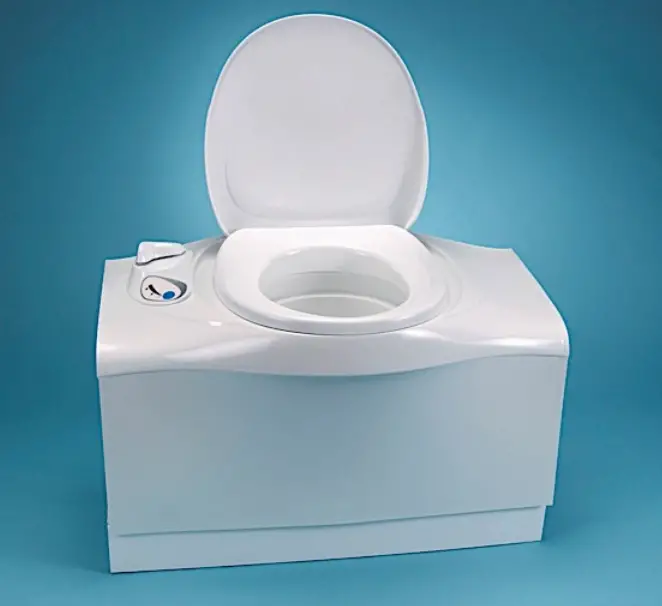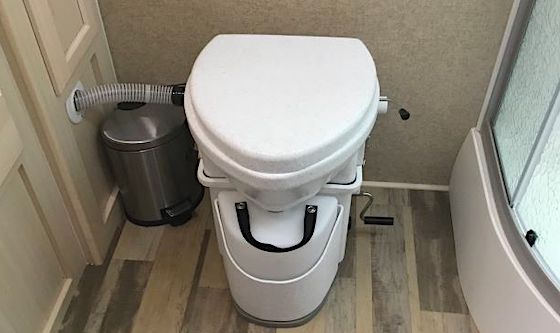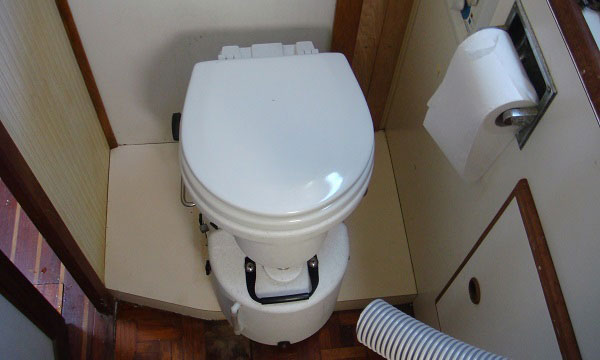How Does An RV Toilet Work? [DIY & Odorless Options]

The first RV with a bathroom was built in 1927, but most RVs did not have a working bathroom until the 1950s. Since then, a working bathroom has become an integral part of RVs, yet few people know how RV toilets work.
In short, RV toilets work by relying on gravity to take toilet waste to the black water tank and into an underground sewer system via sewer hose. To learn more about how RV toilets work and their parts, read on.
The toilet system in your home works by water pressure systems. Whenever you flush the toilet, water pressure forces the water and waste through a series of pipes until it exits the building. Normally, these pipes feed into other sewer pipes at a city or county treatment plant or into a septic tank.
RV toilets work differently though. Instead of relying on water pressure to remove waste, RV toilets rely on gravity. Some RVs may have systems that rinse the bowl and fill it from the bottom, but that water pressure is often not powerful and forces the RV to still rely on gravity to a large degree.
Thus, RV toilets work by relying on gravity to transport toilet waste from the toilet to the black water tank. Once the waste is in the black water holding tank, it remains there until it is emptied through a sewer hose into a proper dump station receptacle. In older RVs, the waste may dump directly into a holding tank below the toilet, much like a porta-potty.

Here’s a simple breakdown of how RV toilets work:
Since RVs typically have sinks and bathrooms, they have a lot of different parts related to the toilet. The two most important parts of an RV toilet are the water tanks and sewer hose.
The water tanks are imperative for having a functioning RV toilet. If your RV has a sink and bathroom, it is likely to have three different water storage tanks below it. Here are the three different tanks your RV may have:
Fresh Water Tank: The fresh water tank holds and allows you to transport fresh drinking water. This water may also be used to rinse out your toilet bowl, feed into your shower, and offers water for any other device that may need it. Fresh water tanks can normally hold 60+ gallons.
Gray Water Tank: The gray water tank stores dirty water from sinks and showers. This tank is only designed for liquid so do not let non-liquid go into this tank. Anything bigger than 1 to 1.5 inches will clog the tank. Gray tanks normally hold 30 to 40 gallons.
Black Water Tank: The black water tank is designed to hold waste and toilet paper from your toilet. The emptying pipes of the black water tank are normally two times thicker than that of a gray water tank, which allows the waste in toilet paper to not clog the tank. Black water tanks can typically hold 30 to 40 gallons.
The sewer hose is another highly important component of an RV toilet. The purpose of the sewer hose is to cleanly and safely transport waste from the gray and black water tanks to an underground sewer system.
Unlike most movie depictions, RV sewer hoses are normally sanitary. A sewer hose is normally made from a flexible plastic tube that is 3 to 4 inches wide and about 10 to 20 feet long. For most RV purposes, you will only need one hose. You might need an extension though, which requires adapters to seal between the two hoses and prevent leaks.

Sewer hoses allow a clean and safe transport of waste by connecting one end of the hose to the water tank and connecting the other end of the hose to a ground sewer system.
To connect the hose, RVs come with a black PVC installation under the camper. It will have two valves that open and close the gray and black water tanks. The RV should label the two tanks in some way.
There should be tabs sticking out of the opening at the end of the black PVC. This is where the sewer hose attaches. Attach one end of the sewer hose to these tabs. Additionally, there should be a hole in the ground at a fully developed dump station. Place the other end of the sewer hose down the hole.
When dumping your waste, dump the black water tank first. Then, empty out the gray water tank. The reason you want to dump the black water tank first is that the gray water will flush out the sewer hose and clean out any waste left from the black water tank.
If you’re finding that the sewer hose does not completely flush out the waste in your tank, you can purchase special pumps that are designed to suck out waste from RV tanks.
The best way to prevent odor from escaping your RV toilet is to use chemical treatments that deodorize your toilet and sewer system. These chemicals will also breakdown solids and toilet paper, preventing any clogging or buildup. Here are popular treatments for toilet odor:
Blue Chemical Treatment: Blue chemical treatments are powerful breakdown agents. If you are dumping your toilet into your home’s septic tank, do not use a blue chemical treatment because it can ruin pipes and kill good bacteria.
Biological Treatment: Biological treatments use bacteria in other enzymes to breakdown materials in the black tank. It is more environmentally conscious and will not hurt the septic tank.
To maintain your RV toilet, pay attention to these three areas that may need tune-ups:
Toilet Seals: Toilet seals are rubber seals that prevent seepage from the toilet onto your bathroom floor. The toilet seals can dry out or become rigid, making them ineffective. To prevent your seals from drying out, take the toilet apart and spray the seals with rubber conditioner. This will prevent you from needing to replace the seals entirely.
Pipe Connections: Your pipe connections are imperative to keeping water within the pipe without leakage. You will want to look over your pipe connections once a year because the connection adhesives can degrade within a year. Use silicone caulk to seal the connections if needed.
Black Tank Flushing System: A black tank flushing system is one of the best ways to maintain your sewer system. The system can break down build up inside the tank and clean off any sensors. If your RV does not already have a black tank flushing system installed, you can install one yourself.
Some RV toilets, use composting toilets, check our detailed composting toilets post.